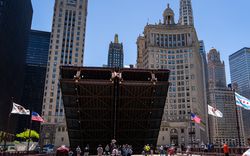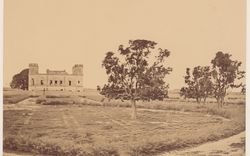Holdings
Emma Rath on photographs of Álvaro Siza's public library in Viana do Castelo
The transition from analogue to digital photography in the early 2000s resulted in new dynamics and possibilities for architectural representation, as firms enthusiastically adopted these technological advancements to document construction sites. Seemingly endless images of designs and buildings in process can be taken on memory cards with the capacity to store hundreds of photos, redefining the term “point and shoot.” Precious thumbnails printed on contact sheets, now largely obsolete, have been replaced with ink stripes running across letter-sized 8 ½ x 11” paper.
An archival banker’s box is wheeled out from deep storage in the CCA vaults into the Study Room, holding over one thousand print photographs of Álvaro Siza’s Biblioteca Municipal De Viana Do Caselo. Situated between Alameda 5 de Outubro and the Lima River as part of a broader waterfront development plan, the project included a multi-use pavilion, two office buildings, an auditorium, and a two-story, orthogonal library.
The documents have been removed from their original binders and methodically placed in file folders to maintain their sequence. The photographic contents range from minuscule details to macroscopic overviews; viewing this series feels like a disorienting dance, flipping between wide-angle landscapes of the construction site to detailed views of mortar lines running across surfaces. Some images are obfuscated—bearings lost, with no clear sense of which way is up.
Hands reappear across images, redressing this vertigo.
Across the extensive photographic documentation of the library project, hands provide a sense of scale, grounding the images and keeping them from slipping into abstraction. The reappearing hand, a universal architectural measure, gives the viewer context about the spatial environment of the construction site. It is a human-scale reminder that an individual is still behind the photograph and design. These hands capture the design-build approach, illustrating the collaborative work of architecture. They draw attention to the work often forgotten when shiny buildings are revealed in their finished form.
In the documentation of Álvaro Siza’s project, the simple yet discerning reappearance of hands to trace movements across the site bridges the gap between abstract ideas and tangible realities. These working documents of architects sketching on building parts or handling materials reveal an intimate and detailed experience of the site. Fingerprints of past workers mark the archival documents, bearing material memories of actions, exchanges, and decisions in their barely visible vestiges, like tiny contour lines of the working site. These bodily gestures, pointing to us from the past, indicate where to look within the frame. They highlight, hold, and fundamentally build not only Siza’s project but also our understanding of it. This is a generous decision shared by the building’s makers; it will continue to guide the viewer’s gaze to help make sense of the cacophony of the building site and its ongoing reception.
The integration of bodily scale into architectural representation underscores the intimate connection between the physical act of construction and its documentation. It foregrounds the importance of context in architecture photography; a reminder that images are not just representations but also tools for understanding the collaboration between people, design, and building.
How many hands did it take to build the library? How many hands will leaf through these images for years to come?

















